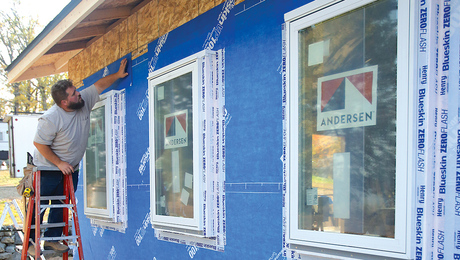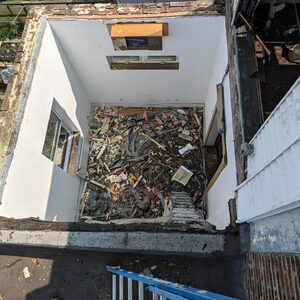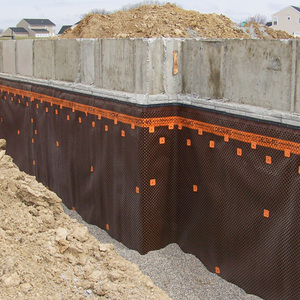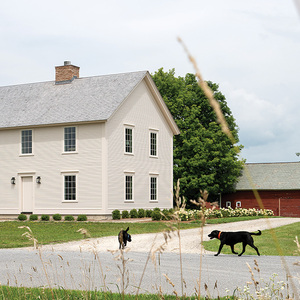I am remodelling a home and would like to make it ‘cable ready’ but I am confused between the wiring requirements for digital cable tv and satelite tv. Am I correct in thinking that from the point of entry the in wall wiring to each tv location is the same? i.e. RG6. From the point of entry for digital cable I guess it would be RG6 to the street, correct? And for satelite it would be RG6 to the satelite dish? So ‘cable ready’ would mean having RG6 from the point of entry to each tv location only? The respective provider worry about the rest?
Would it be a good idea to run cat5 to each tv location as well? Is it neccesary for both cable and satelite?
Discussion Forum
Discussion Forum
Up Next
Video Shorts
Featured Story

Getting the details right for a wall assembly with the control layers to the exterior and lots of drying potential.
Featured Video
How to Install Cable Rail Around Wood-Post CornersHighlights
"I have learned so much thanks to the searchable articles on the FHB website. I can confidently say that I expect to be a life-long subscriber." - M.K.
Fine Homebuilding Magazine
- Home Group
- Antique Trader
- Arts & Crafts Homes
- Bank Note Reporter
- Cabin Life
- Cuisine at Home
- Fine Gardening
- Fine Woodworking
- Green Building Advisor
- Garden Gate
- Horticulture
- Keep Craft Alive
- Log Home Living
- Military Trader/Vehicles
- Numismatic News
- Numismaster
- Old Cars Weekly
- Old House Journal
- Period Homes
- Popular Woodworking
- Script
- ShopNotes
- Sports Collectors Digest
- Threads
- Timber Home Living
- Traditional Building
- Woodsmith
- World Coin News
- Writer's Digest


















Replies
My understanding, is that cat 5 is not required for either but may be necessary for something down the road. From personal experience, cable and satelite use the same wires.
run conduit to each location so you can change the wire as it improves
In the case of Satellite, you may or may not need cable from the dish to each TV location. For instance on my setup (DirecTv) I have two RG-6 from the dish to a multiswitch in the basement. Then from there I have four lines feeding four receivers throughout the house. So the RG-6 from each TV does NOT run to the dish. If I go with Hi-Def, I will have four lines coming into a new multi switch and the same cables that are currently distributing signal throughout the house will continue to do so.
My advice would be to pick a convenient place in the house to make connections. (Unfinihed basement, garage, crawl, etc) then home run each TV RG-6 to that point. That way no matter what comes into the house, it can be distributed appropriately. If you have a spot where you anticipate a DVR, home run TWO RG-6 cables. My DirecTv DVR has two tuners in it- I think they all do. Each tuner requires its own RG-6 cable.
And whatever you do, DON't split any of the lines - home run all of them to an easy access point. Those cheap splitters don't work with Digital Cable or Satellite. You may also want to put a duplex outlet somewhere close to where all the cables meet up. Some of the satellite multi switches are powered and others are passive. But it won't hurt to have 120V handy if you need it.
Don't forget phone lines as well. Our Dish Netowrk receivers need to have the phone lines plugged into them. I believe it's for updates, pay-per-views, etc.
"Preach the Gospel at all times; if necessary, use words." - St. Francis of Assisi
My house is wired with a Leviton Structured Media Panel in the garage. You can buy the panels and modules at Home Depot relatively inexpensively. I think Lowe's offers a similar system by Pass & Seymour. Go for something above and beyond the small box - it gets hard to fit everything inside.
http://www.leviton.com/OA_HTML/ibeCCtpSctDspRte.jsp?section=10336&minisite=10027&sitex=10027:22372:US
In my case, Phone and Cable Service were run from the side of the house to this panel by the builder. Instead of cable I have DirecTV. Basically, the services are run in to the panel and connected to terminal block modules. Wires then run from the modules out to each point in the house. When adding DirecTV, they ran 2 coax from the roof to the panel in the garage where I can connect the feeds to any of the TV jacks in the house.
I would definitely run the wires in conduit where possible. Makes life much easier down the road if you have to add something.
You also want to run a phone line (I just used Cat5 cable) to each TV jack location if you plan to use Satellite. The receiver uses the phone line for ordering pay per view. If you have CallerID on your phone service, DirecTV will also display the call on the screen assuming that it is plugged into the phone line.
If you want to "futureproof" the house, use blue or orange "Smurf tube". It's easier to use than more rigid conduit and will allow any changes to the cabling later. If you run RG-6 coax anad Cat5e, you should be safe for a while. HD can be sent through Cat5e, whether it's component video, composite or HDMI and it's converted to those by using a part called a balun. Digital cable (I don't know what they broadcast in analog) and satellite both use RG-6. Use Quad shield if you need to suppress a lot of noise.
If you will want to watch direct broadcast local HD channels, you'll need another coax at each location, so if you want to cut down on the coiling/uncoiling of individual cables while you're trying to keep everything organized, bundled coax/Cat5e is available in several configurations and they may/may not have a plastic jacket over them. The kind that has 2 coax and 2 Cat5e should handle most situations, unless you want to send HD programming to several TVs from one source, in which case, you'll need a distribution amplifier.
I will never buy the orange smurf again. It is not listed ENT and definitely inferior quality. Now I just reidentify the ends of LV smurf runs with colored tape.I just used smurf in my addition and you will notice one orange and one regular blue with red tape on it. "Fool me once ..."http://esteroriverheights.com/electrical/addition/17smurf_job.jpgFor your "windbracing" thread followers, this is how we brace trusses in Fla, See the 2x4 "X" braces? This keeps the trusses from racking on a lateral load.
ENT?
"I cut this piece four times and it's still too short."
ENT
Electrical Nonmetalic Tubing AKA smurf tube. (a listed raceway)
The orange stuff is "innerduct", the way they keep different media separate when you share a big pipe. People just use it for a low voltage raceway because they don't really have much NEC guidance on this.
Why is the Orange smurf tube so bad for low voltage? Greybar, HD and all of the other places where I see it lists it for low voltage use.
"I cut this piece four times and it's still too short."
I would DEFINITELY run data cable as well as coax to any entertainment centre. I am regretting it already; I can't believe I didn't think of it, and I'm a computer nerd by trade. Internet radio, MP3 streaming, and eventually video streaming will all benefit from data access. Now I'm having to buy one of these:
http://www.sondigo.com/sirocco/overview
...which I've heard works well, but I could have avoided it with a simple Cat 5 run.
Scott.
Always remember those first immortal words that Adam said to Eve, “You’d better stand back, I don’t know how big this thing’s going to get.”
One other thing comes to mind that I missed in my installation...
Even 'ordinary' audio receivers seem to have multi-channel audio decoders in them for 5:1, 6:1 or 7:1 audio. If you're going to get into this stuff be sure think about speaker placement and therefore speaker wiring. I'm told that wireless speaker solutions are still a long way away and will always be more expensive than a bit of copper wire.
Scott.
Always remember those first immortal words that Adam said to Eve, “You’d better stand back, I don’t know how big this thing’s going to get.”
To avoid an additional montly fee of five dollars you have to have your dish network receiver plugged into a phone line.......I know just got rid of my land line and have dish network.
5 dollars a month extra for something I am not getting, to get pay perview movies which I have never done and for them to tell me something is wrong with the receiver, which they never done except maybe after I called them. The local cable company doesnt require a phone line anymore why should dish network. Seems to me just another scam fee.
May have to go back to cable
Dan
I think the real reason they want the phone line is so the receiver can "call home" every night to tell them what you've been watching = free market research.Scott.Always remember those first immortal words that Adam said to Eve, “You’d better stand back, I don’t know how big this thing’s going to get.”
Some satellite TV require a homerun for each point. RG 6 from each point to the main .
A house I finished lately had 5 CATV home runs in it each to a separate room. I happened to be there when the satellite installer was there the day before move-in. He informed me that "my" installation was wrong because you have to have two RG6 home runs at the location where the DVR was going. Like I knew where that was to be. For all I knew the people were getting cable. Does cable require a separate home run for the DVR?
Sats have dual vertical polarized and horizontally polarized channels. And that requires 2 LNB's. For a single receiver it sends a signal to select which LNB is used for that channel. Then the coax returns all of the channels on that LNB.For multiple TV the receivers connect to a multiplexer or multi-switch. Cables for each LNB feed continously both sets of channels to the multiplexer and depending on which channel that receiver is on it the signal is used to select which LNB connects through the multiplexer.The sat Tivo's and probably the other sat DVR's have dual tunners in them and can record 2 channels at one time. And thus one selected might be on one LNB and the otheer on the other LNB. Thus it needs to coax's to the multiplexer.Many of the DVR's for cable can also record 2 channels. But all of the channels are on one cable and only one connection is needed..
.
A-holes. Hey every group has to have one. And I have been elected to be the one. I should make that my tagline.
coupla Qs....
what does the acronym LNB stand for?
So, are you saying that from now on I need to have 2 RG-6 cables run to every CATV jack in the house just in case they want a satellite DVR in that location? :-)
Low Noise Block (down converter).It is that lump that mounts on the arm in the dish.Yes, two coax have been common for a long time. That what structured cables use.Although I think that the 2nd is for things like bring in security cams or being able to distribute output from a DVD/DVR to other TV's..
.
A-holes. Hey every group has to have one. And I have been elected to be the one. I should make that my tagline.
Here is a FAQ that you might find helpfull.http://www.tivocommunity.com/tivo-vb/showthread.php?t=55509.
.
A-holes. Hey every group has to have one. And I have been elected to be the one. I should make that my tagline.
Thanks Bill. Good background info.
It sounds like the bottom line is that a satellite dish requires 2 RG-6 cables from the location of the dish to the place where the "box" will be located?
Really though if a home buyer wants to buy structured wiring I will be hiring a sub to deal with that. That will be mostly out of the budget for the types of houses I build which only go into the $200s. If they don't want to pay for that I guess I need to just ask people if they plan to use satellite. If so I'll tell them they need to find out what coax connections they need and at the very least they probably need to buy a double coax to the "main location". Maybe my first step will be simply adding "double coax CATV outlet for satellite" to our price list, which will essentially be the same as two CATV outlets. That will "CMA" - similar to CYA.... Generally, they get 3 CATV outlets per house. Actually, one I'm building right now the guy said he wanted 2 cables to the TV niche. That was a first (someone asking for it ahead of time). I actually just gave him the extra cable. I get the idea that he is a techno geek.
Generally though, that is the way this business (or maybe any business works): You set up a set of standards. If someone wants more than the standard, they pay extra...
You talk like structured wiring should come standard in homes. I'm gonna talk to a few guys who work for my sister company and find out what they put as a standard in the $500k homes, 1 mil homes and 1.5 mil homes. Right now, adding expense to homes isn't the right thing to do - not the way the RE market is.
In my own home I have 1 or 2 "connection blocks" in each room with 1 coax RG-6, and 2 cat-5e - one with an RJ11 and one with an RJ45. These lead to a junction box in a closet that has one conduit going to the crawl space and another that goes to the attic. I'd say we currently use about 15% of that capability so maybe it was a waste of time and money... Next house I'll likely drop the RJ45 stuff. I did all the hook-ups so it probably wasn't that expensive, but it was time consuming. We just have HD cable TV and internet though. To my (limited) knowledge, cable is about 2x the monthly cost of satellite, but also about 2x as reliable due to bad weather drop outs. I'm thinking that really we might be fairly typical for urban or suburban households. I imagine satellite is much more common in rural settings. I really don't build rural though.
BTW - on another house the guy had me put in a phone line in the TV niche. I'm guessing that might be for DSL for some kind of gaming stuff?
I did not mean to indicate that installing structured cable was standard. Rather that runnin 2 coax was not that uncommon either.If you look back at any of the discussions about prewiring a house here and usually 2 coaxs where recommended.Tivo's require a phone or high speed internet connections for downloading updates and program guides. And with broad band connection you can share programs with others, remote scheduling, and I think download other programing."News, sports, weather, technology, music, education, and more: Send programs straight to your broadband-connected TiVo DVR–free of charge! With over 75 video partners including the New York Times, CNET, The Onion, Vogue.TV and more, TiVo offers more choice than cable or satellite. New videos get added every day, so visit often. * Video downloads are constantly updated, with new videos added every day
* Download just one episode or Get a Season Pass to get automatically deliveredNext
Watch YouTube videos on y""TiVo also has fresh movies and commercial-free TV shows available to download through your broadband-connected TiVo DVR. * Rent or buy over 20,000 TV and movie titles from Amazon Unbox
* Start watching them within minutes*
* Enjoy movies the same day they are released on DVD"And sat needs a phone connection. It is used for ordering pay for view, but also for the sat company to verify the location.Many of the sat companies are supplying their own DVR/receivers now and I have no idea what they require or if they of the any of the internet features that tivo has.And I have no idea what cable boxes have in the way of those kind of features. But since most cable is now bidirectional and supports broadband I know that they handle PPV over the cable and I would assume any internet features if they have them.I would suggest installing a cat 5 at the main TV location so that it could either be hooked up as phone or internet. But I realize your price point.And there are a number of internet "systems" for audio and video that it would be handy to have an internet connection at the TV.Maybe this is a option for you. Run one coax to for the TV. And with it run a smurf tube. If the routing permits run it to where ever the coax ends up. Then you add coax and/or cat 5 as needed.But I suspect that often the path would be such that you could not fish it (more than a total turns of 360 degrees). Then run it to the attic. And a separate one from the attic to the termination point..
.
A-holes. Hey every group has to have one. And I have been elected to be the one. I should make that my tagline.
"It sounds like the bottom line is that a satellite dish requires 2 RG-6 cables from the location of the dish to the place where the "box" will be located? "That's not entirely true. If by box you mean the multiplexer then you may need more than two RG-6 lines from the dish to the multiplexer. If by "box" you mean Satellite Receivere, then that statement is false. You need TWO RG6 if you want a Tivo with Dual tuners. But the Two cables come from the Multiplexer, not from the dish. DirecTv offers a 4 LNB dish for receiving regular programming, local channels, High Definition, and Foreign Programming. In that case, you would need 5 cables from the satellite dish to the MultiPlex switch. Maybe you should just run conduit and let the future owners decide .. . .
The local phone company got into tv with fiber optics. I inquired and was told I need cat5 wires in the house. Fiber optics end at the outside wall.
To keep away from an additional monthly charge of five dollars, Dish Network requires customers to connect their receiver to a phone line. However, since I've recently gotten rid of my landline, I'm facing this fee despite not using pay-per-view movies or needing receiver maintenance unless I contact them. Unlike the local cable company, Dish Network still insists on this connection, which feels like an unnecessary and frustrating charge. Considering this, I might consider returning to cable services.If you want then you also visit:
The local phone provider started using fibre optics for television. When I asked, I was told that the house needed cat5 wires. The exterior wall is where fibre optics stop.